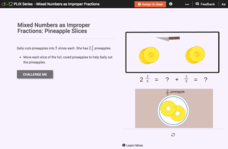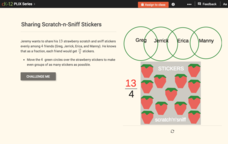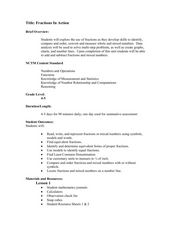Intensive Intervention
Fractions as Numbers
Your learners will enjoy thoroughly understanding fractions, and you will appreciate the abundant, quality resources in this comprehensive unit that builds toward a complete understanding of the concept of fractions as numbers. Many...
CK-12 Foundation
Mixed Numbers as Improper Fractions: Pineapple Slices
Practice adding and subtracting improper fractions with pineapple slices. Young mathematicians move whole pineapple slices to visualize the addition of the 2/5s that is on Sally's plate. Pupils also use a combination of mixed numbers and...
CK-12 Foundation
Improper Fractions as Mixed Numbers: Sharing Scratch-n-Sniff Stickers
No, you can't actually smell these 13 scratch-n-sniff stickers. But you can group them into equal groups of four, with one sticker remaining. Using that information, learners create a mixed number based on the improper fraction, 13/4.
Curated OER
Fractions in Action
Investigate equivalent fractions with your class. They compare and order fractions. Then they work cooperatively in groups to experiment and problem solve with fractions using a game format. Multiple resources are provided.
Virginia Department of Education
Adding and Subtracting Fractions
Your learners will enjoy playing a game as a motivator to learning and remembering the adding and subtracting of fractions.
CK-12 Foundation
Equivalent Fractions: Number Line
Arrange improper fractions on a number line to determine the equivalency to whole numbers. The number line starts at -4 and ends at 4, while users must turn the improper fraction into a proper fraction in order to place it on the number...
K20 LEARN
Baking Cupcakes!: Fractions
Following an engaging video, mathematicians solve a word problem about baking cupcakes using fractions. Scholars practice different problem-solving strategies, then find different ingredient amounts for their recipes. Pupils solve a...
Rational Number Project
Initial Fraction Ideas Lesson 18: Overview
Develop young mathematicians' ability to compare fractions with investigation into the number 1/2. After brainstorming a list of fractions equivalent to 1/2, children identify a pattern in the numerators and...
CK-12 Foundation
Fraction and Mixed Number Comparison: Pumpkin Pie
Compare fraction models to fractions on a number line in an interactive that uses pumpkin pies as the model. Pupils look at pumpkin pie models to determine their improper fraction value. They use their knowledge to answer five questions...
EngageNY
Collecting Rational Number Like Terms
Teach pupils to handle fractions fluently. The sixth installment in the series of 28 has class members apply the concepts learned in previous lessons to expressions with fractional coefficients. The fractions are both mixed numbers and...
Curated OER
Finding Common Denominators to Subtract
Subtracting fractions with unlike denominators can be overwhelming, but in this task, 5th graders work systematically to break down the procedure through three questions. The first two questions ask for pictures to be drawn along...
National Research Center for Career and Technical Education
Photoshop Scale
Say cheese! Can your class take a great photo and size it to fit any need? A career and technology-centered lesson plan demonstrates the correct way to resize images in Adobe Photoshop. Scholars view a presentation and work individually...
Illustrative Mathematics
Mixed Numbers with Unlike Denominators
There is more than one way to add mixed numbers. This worksheet asks 5th graders to find and record two ways. The purpose is to help pupils realize there are different ways to reach a common solution in math. The two most common ways are...












